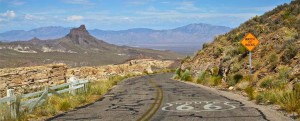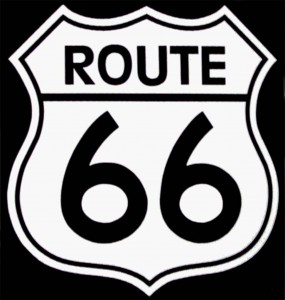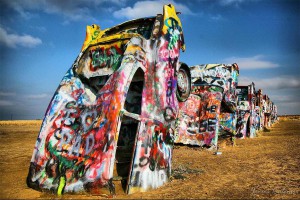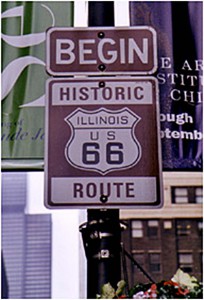“It winds from Chicago to L.A., more than 2,000 miles along the way. Get your kicks on Route 66.”
Call it the Mother Road, the Main Street of America or the Will Rogers Highway. U.S. Route 66 may just be the most famous stretch of tarmac in America, and it lives on despite officially being decertified by the federal government on June 27, 1985.
Perhaps only New York’s Broadway has been more celebrated on film and television and, of course, in song. The song, “Route 66,” was written by a nearly penniless wannabe song writer Bobby Troup and turned into a 1946 smash hit by Nat King Cole, the tune encouraging countless millions of Americans to “motor west,” and transform California into the country’s most populous state.
The roots of Route 66 actually date back to 1857, when a U.S. Navy officer, of all things, was sent out to create a wagon trail along the 35th parallel. Lt. Edward Fitzgerald Beale actually recommended using camels to help settlers and military caravans navigate the harsh deserts along the way.
(Street drag racing to be a feature of 2016 Woodward Dream Cruise. Click Here for the story.)
Portions of Beale’s trail were eventually incorporated into what, in the late 1920s came together as U.S. Route 66. Early motorists struggled to travel more than a few miles in much of the country, and could count on very few stretches of paved road heading west of the Mississippi. Some of the earliest roads, such as the Lincoln Highway, were actually funded by private effort, but Washington eventually agreed to a new system that would be jointly run by the federal government and the various states.
The compromise created plenty of challenges, especially when it came to laying out a route for the Chicago-to-L.A. road. Indeed, even coming up with a numeric designation touched off a lengthy political battle. Ultimately, Cyrus Avery, an entrepreneur and early “good roads” proponent, won out with Route 66, something he thought sounded good – and which also had positive meaning to fans of numerology.
In its earliest incarnation, the Motor Road combined three of those semi-public routes, including the Lone Star Route, the National Old Trails Road and the Ozarks Trail. It also picked up some postal roads and various local highways, linking them together in one nearly transcontinental stretch of pavement.
Over the decades, U.S. Route 66 wound and meandered much like a river, segments occasionally being abandoned due to a mix of politics and highway engineering efforts. A number of those abandoned stretches can still be seen in places like the Cajon Pass through California’s San Bernadino Mountains.
Through some of the drier stretches of the highway rusted hulks of old Model Ts and other primitive vehicles still can be found where they failed to negotiate a mountain turn or simply stopped running. There was a reason the highway was known to many as “Bloody 66.”
Many of those old jalopies belonged to “Okies,” farmers who fled the Dust Bowl drought of the 1930s, hoping to find a new start in the promised land of California. When World War II came, the highway became a major route for military shipments to the West Coast. And after the war, it beckoned to returning soldiers who also hoped to find new life in the Golden State.
That included a down-on-his-luck songwriter by the name of Bobby Troup who figured he’d do better moving to Los Angeles. He lucked into a meeting with Nat King Cole and mentioned the song he was writing about the highway Troup had just used to cross the country. Cole recorded it in 1946, quickly selling a million copies and creating a tune that remains popular 70 years later.
(Brexit vote shocks automakers as they take big stock hit. Click Here for more.)
But the popularity of the Mother Road itself was already beginning to fade, especially after the passage of the National Interstate and Defense Highways Act of 1956. One stretch after another was decommissioned, the last, near Williams, Arizona, replaced by Interstate 40. The American Association of State Highway and Transportation Officials officially decertified Route 66 on June 27, 1985.
There were plenty of battles in the final years, local businesses, in particular, feared being forgotten as the new interstates bypassed the little towns like Winona, Kingman and Barstow mentioned in Troup’s lyrics.
That’s led a number of states to maintain the “66” designation, often referring to those stretches, in places like Flagstaff, Arizona and through California’s Mojave Desert, as “Historic Route 66.” Elsewhere, segments have been renamed as state routes retaining the “66.”
Public interest has never completely gone away. TV viewers – and those who prefer to use YouTube – can still find old episodes of the ‘50s-era series, “Route 66.” And Nat King Cole’s rendition is just one of the many renditions of Troup’s classic lyrics. Meanwhile, Pixar creative director John Lasseter used a cross-country family trip as inspiration for the wildly popular film, “Cars,” which celebrated a stretch of old and near-forgotten road modelled after Route 66.
So, today, even 31 years after it officially ceased to exist, the Mother Road remains perhaps the best-known highway in America.
“Won’t you get hip to this timely tip? When you make that California trip, get your kicks on Route 66.”
(Jeep electrified. SUV maker planning plug-ins, EVs. Click Here for more.)






Thanks for the Rt.66 article. From Moriarty, NM to west of Albuquerque NM, the route goes over it’s second highest point. 7000 ft, Sedillo Hill into Zuzax NM. It is also one of it’s most scenic parts going through the end of the plains and across the southern tip of the mountains. In Albuquerque is the Unser Museum and the longest urban stretch along Central Ave. Lots of fun places around University of NM. Yep we love it!
I didn’t work this into the piece but one of the most memorable media drives I participated in was the launch of the C5 Corvette, some years back. The event traced the entire old Route 66, at least as much as possible, and I joined in for the latter portion. We meandered and wound up driving through the Mojave Desert, stopping at a reborn ghost town taken over by a Hollywood stunt man who turned it into both a tourist destination and a film location. The other memorable point along the route was Oatman, AZ, with its wild donkeys wandering everywhere.
Paul E.
Very nice, Paul. Very nice.
This May, my friend Al Bernstein and I decided to celebrate 50 years of friendship and his retirement by doing something we have been talking about for over 30 years – Route 66.
But we decided to do it in a different way… We went from West to East and we did it in a 1969 Ford Galaxie 500 Hdt I bought in San Jose, CA.
You can read all about the trip at 50yearroute66.wordpress.com. We did 4k miles in a 47-year old car that we bought sight unseen. And the only problems we had were with tires!
We never pre-booked hotels and never set goals for each day. We just enjoyed.
It was a wonderful trip and I recommend it to anyone who has the time.
Fred
Here in IL I actually take a portion of the original 66 everyday to the office and our location is right next to 66. There is a diner / restaurant, (Dell Rhea’s) Chicken Basket that opened in 1938, originally a sandwich counter from the 1920s, during 66’s heyday and it has tons of memorabilia. I-55 runs parallel to 66 in this area. Great food!!
Another funny thing I bought one of my vehicles from a dealer just a few miles east from the office on the same stretch of Route 66.
I’d like to drive the entire route from here to CA; think it would be more scenic than taking I-80 (the east-west version of I-65).